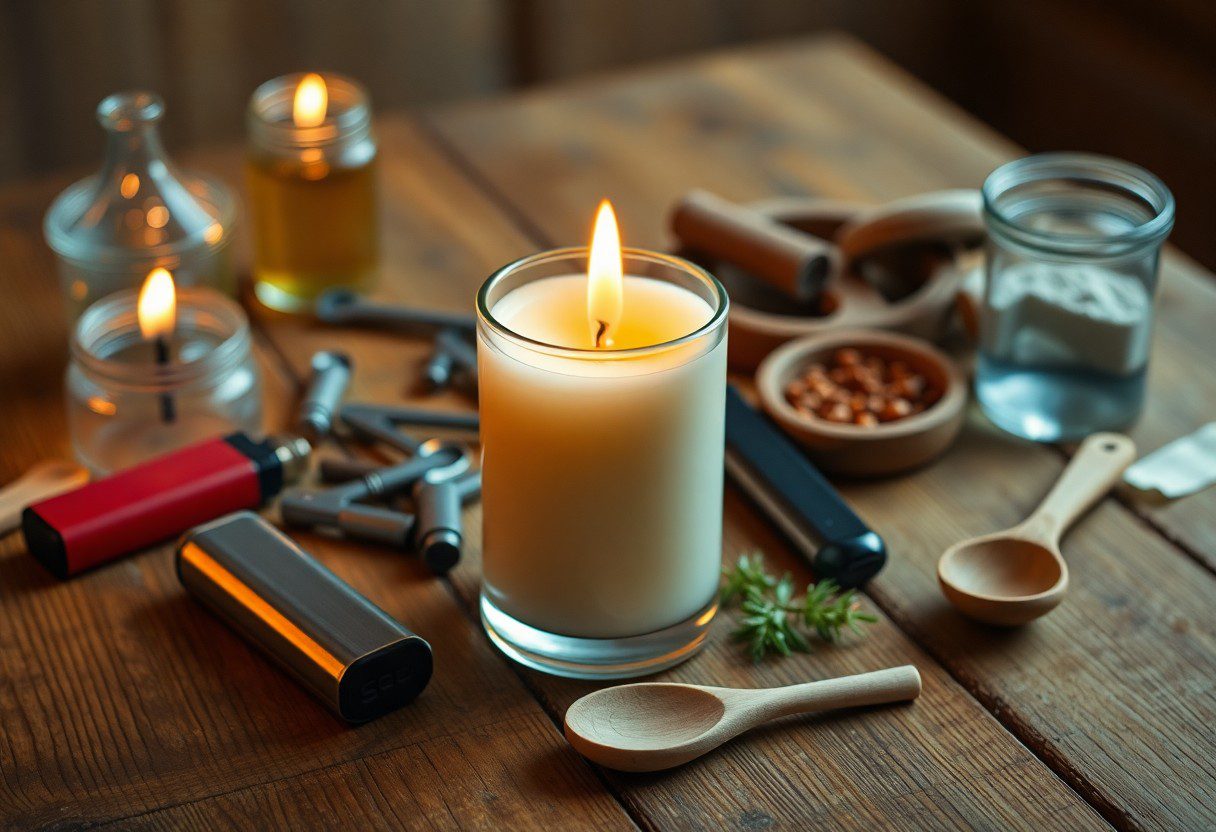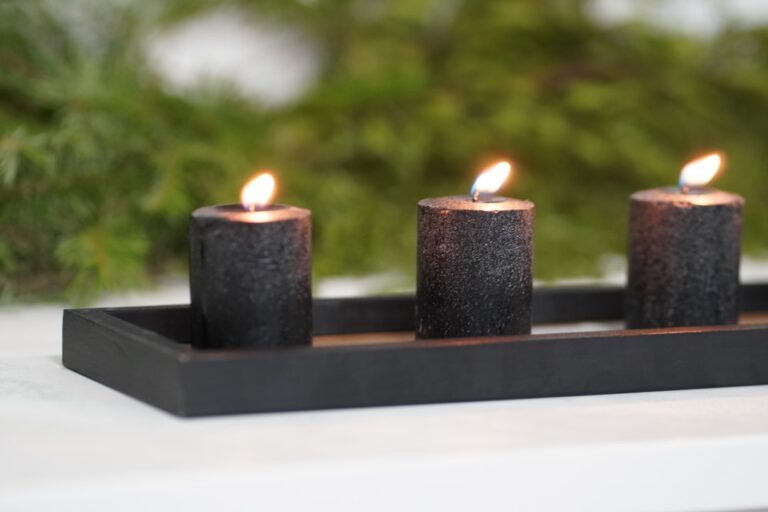how to fix candle tunneling without foil
Just addressing candle tunneling can save your favorite scented candles and enhance your home’s ambiance. This common issue occurs when the wax burns unevenly, leaving tunnels in the center while the outer edges remain untouched. By following some simple techniques, you can revive your candles and ensure they burn properly without resorting to foil. In this post, you’ll discover effective methods to fix your candle tunneling and maximize your candle’s lifespan, making your space brighter and more inviting.
Understanding Candle Tunneling
The phenomenon of candle tunneling can be frustrating for candle lovers who want an even burn. When tunneling occurs, the wax around the wick burns down much faster than the wax at the edges, resulting in a tunnel-like effect. This not only affects the candle’s lifespan but also the fragrance throw, leaving you with a partially used candle that struggles to deliver its full potential.
What is Candle Tunneling?
By definition, candle tunneling is when the wax around the wick burns unevenly, creating a deep tunnel while leaving the outer edges largely untouched. This can lead to a waste of your candle, as unburned wax accumulates on the sides and the candle experiences a poor scent throw.
Common Causes of Tunneling
By knowing the common causes of candle tunneling, you can prevent it from happening in your candles. This issue is often a result of factors such as your candle’s burn time, wick size, and the type of wax used. Insufficient burn time on the first use can lead to a wax pool that doesn’t reach the edges of the container, creating the perfect environment for tunneling to occur.
This problem is typically exacerbated by the type of wick you use; for instance, a wick that is too short may not produce enough heat to melt the wax at the edges. Similarly, using a non-corrective wax blend can also contribute to tunneling. Additionally, a drafty environment or placing the candle near chilly surfaces can cause uneven burning, impacting your candle’s performance. Understanding these factors allows you to make more informed choices and enjoy your candles to their fullest potential.
Preventive Measures
Even if you’re dealing with candle tunneling, taking preventive measures can save you from this issue altogether. Start by understanding the factors that contribute to tunneling, such as the type of wick, wax quality, and your burning habits. By choosing wisely and following the right techniques, you can enjoy an even burn and maximize the lifespan of your candles.
Choosing the Right Candle
Across a vast selection of candles, you’ll find that not all are created equal. Opt for high-quality candles made from natural waxes like soy or beeswax, as these tend to burn more evenly and are less prone to tunneling. Additionally, be aware of the wick type; wooden wicks often provide a better burn compared to cotton ones.
Proper Burning Techniques
Around your candle’s first burn is where you can make a real difference. You should allow it to burn long enough for the entire surface to melt and pool; typically, this means burning for one hour per inch of the candle’s diameter. This allows the wax to melt evenly and reduces the chances of tunneling.
In fact, it’s vital to ensure a proper burning technique for maximizing your candle’s lifespan. When you light your candle, burn it until the wax has melted across the entire top surface. This practice helps establish a “memory” so that subsequent burns will maintain an even burn. This not only prevents tunneling but also enhances the scent throw. Additionally, keep your wick trimmed to about 1/4 inch to promote a steady flame and reduce soot buildup. Lastly, avoid drafts and extremes in temperature, as these can hinder an even burn and lead to uneven tunneling.
Techniques to Fix Tunneling
While candle tunneling can be frustrating, there are effective techniques you can use to fix it and enjoy your candle to the fullest. These methods not only save your candle but also enhance your overall experience by ensuring an even burn and maximizing fragrance throw.
The Heat Method
Between the various techniques, the heat method is one of the simplest and most effective. By gently heating the top of the candle, you can help melt the wax around the tunnel, allowing the remaining wax to pool and even out the burn. You can use a hairdryer on a low setting or place the candle in a warm area for a short period to achieve this.
Wick Adjustment
After employing the heat method, another valuable technique is adjusting the wick. A wick that is too long can cause uneven burning, leading to tunneling. You can carefully trim the wick to about 1/4 inch before lighting your candle, which can help promote a steadier flame and ensure the wax melts evenly.
Further, maintaining a proper wick length not only boosts the candle’s performance but also enhances safety. A long wick can lead to soot production, increased *flame height*, and even the risk of a fire hazard. By keeping your wick well-adjusted, you contribute to a better burning experience, ensuring both your safety and the longevity of your candle.
Alternative Solutions
Despite the common use of foil to fix candle tunneling, there are several other effective methods you can try. These alternatives offer simple solutions to help you get the most out of your candles while preserving their beauty and fragrance. Below are two practical techniques you can employ to remedy candle tunneling effectively.
Using a Hairdryer
Around the candle, you can use a hairdryer on a low heat setting to gently warm the wax. This helps redistribute the melted wax, allowing it to fill in the tunneled areas. Hold the hairdryer about six inches away and move it constantly to avoid overheating any specific spot. This method is quick and keeps your candle looking great!
Creating a Warm Water Bath
Alternative to direct heating methods, you can try creating a warm water bath for your candle. This involves placing your candle in a bowl of hot water, ensuring the water level is below the candle’s rim. The gentle warmth melts the tunneling wax, allowing it to even out without the risk of damage.
For instance, ensure the water is not boiling, as excessive heat can crack the glass or cause the wax to become overly soft. You should only leave the candle in the warm water for about 10 to 15 minutes. This technique allows for an even melt while maintaining the integrity of your candle. Be careful to avoid spilling water into the candle itself, which can ruin the wick and compromise the scent. With this method, you can enjoy a beautifully burned candle without having to worry about tunneling.
Candle Maintenance Tips
Now, following proper candle maintenance can significantly improve your candle experience and prevent tunneling. Here are some simple tips to keep in mind:
- Trim your wicks before each lighting
- Use a candle warmer for uneven melts
- Keep the candle away from drafts
- Make sure to burn candles for a sufficient duration
- Store candles in a cool, dry place
Any candle enthusiast will benefit from these practices. For more information on this topic, check out How to Fix Candle Tunneling for Good.
Regular Trimming of Wicks
On a regular basis, ensure you trim your candle wicks to about 1/4 inch before lighting. This simple step helps to control the flame size, which in turn reduces soot and prolongs the life of your candle while preventing tunneling.
Storage Conditions
The manner in which you store your candles is imperative for their performance. Ensure you keep your candles in a place free from direct sunlight or extreme temperatures to prevent melting or discoloration.
A storage environment that is too hot can cause the wax to become soft, leading to uneven burning, while extreme cold can make the wax brittle and prone to cracking. Always aim for a stable temperature in your storage area, and be cautious of excess moisture, which could affect the wick and wax. Proper storage ensures your candles remain in optimal condition for a longer lifespan.
Frequently Asked Questions
Unlike common beliefs, fixing candle tunneling can be managed without foil solutions. You may find valuable insights in How To Fix Candle Tunneling: The Ultimate Guide. This resource offers comprehensive tips to improve your candle’s burn and efficiency.
Can All Candles Tunnel?
Candles can tunnel due to various factors such as wick size, wax type, and initial burn conditions. While not all candles are prone to tunneling, many poorly constructed or low-quality candles are more likely to exhibit this issue.
How to Avoid Future Tunneling
Around every candle you burn, take a few steps to prevent tunneling based on the type and quality of the wax used. Proper wick maintenance, ensuring even melting, and burning your candle for the right amount of time can help.
Even when using high-quality candles, you should always trim the wick to about 1/4 inch, allowing for an even burn. Burn your candle long enough for the entire top layer of wax to melt, thus preventing uneven candle surfaces. Prioritize clean burning conditions by keeping your candles away from drafts and using a proper holder. These practices will help maximize your burn time while enhancing the overall ambiance in your space.
Summing up
On the whole, fixing candle tunneling without foil involves a few simple techniques you can apply. Start by ensuring your wick is trimmed to the right length to promote an even burn. You can also create a makeshift heat source, like using a hairdryer briefly to soften the wax and encourage it to melt evenly. Additionally, burning your candles for longer periods can help achieve a full melt pool, preventing tunneling. By taking these proactive steps, you can enjoy a more satisfying and longer-lasting candle experience.
FAQ
Q: What are some effective methods to fix candle tunneling without using foil?
A: There are several alternatives to foil that can help rectify candle tunneling. One method is to use a heat gun or hairdryer to gently warm the top of the candle. This helps melt the wax around the tunneling area, allowing it to even out with the rest of the candle. Another option is to wrap the candle in a towel while it burns. The towel will help trap heat, promoting an even melt pool as the candle burns down. Lastly, consider trimming the wick to the appropriate length before lighting, as a long wick can contribute to uneven burning.
Q: How can I prevent tunneling in my candles from the start?
A: To avoid tunneling right from the beginning, ensure you burn your candles long enough during the first use. Allow the top layer of wax to completely melt across the surface of the candle, which typically takes 1 hour for every inch in diameter. Additionally, keep the wick trimmed to about 1/4 inch before lighting; this helps maintain a steady flame and prevents excessive soot and tunneling. Lastly, avoid placing candles in drafts or near heat sources, as these conditions can disrupt the melt pool.
Q: Is it possible to salvage a heavily tunneled candle, and if so, how?
A: Yes, salvaging a heavily tunneled candle is possible. One effective technique is to scoop out the tunneled wax carefully with a spoon or knife, ensuring you don’t damage the wick. This creates a flat surface for the remaining wax, allowing it to burn more evenly. Alternatively, if the candle’s remaining wax is sturdy enough, you can pour in a new layer of matching wax or a compatible candle wax, which can help fill the tunneled area and create a new melt pool as it burns. Be certain to monitor the candle as you make adjustments to prevent any safety hazards.










